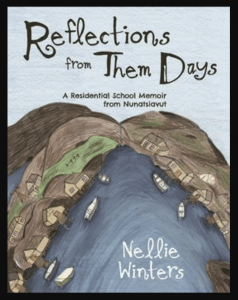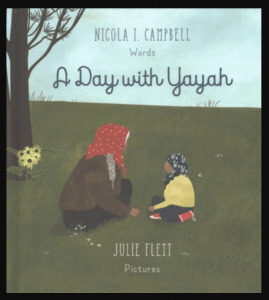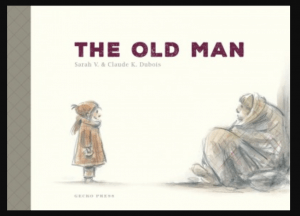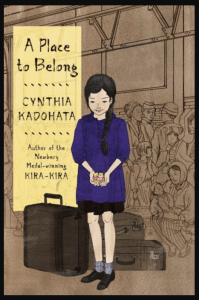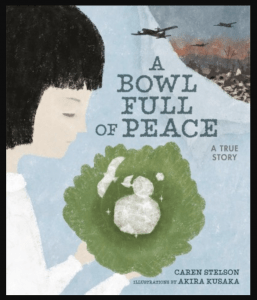Winters, Nellie. Reflections from Them Days: A Residential School Memoir from Nunatsiavut. Iqaluit, Nunavut: Qinuisaarniq, an imprint of Inhabit Education Books Inc., 2020.
In 1949, when Nellie was eleven years old, she was sent to boarding school in Nain, Labrador on the east coast of Canada. In this 51-page autobiography, transcribed and edited by Erica Oberndorfer, she matter-of-factly shares her memories – both sad and happy, heart-breaking and humorous – in a voice truly her own. In the forward, she explains that we are all on earth to help each other and make our world “more wonderful.” This true story – illustrated by the author – will help readers see another life, another perspective, from a time not so long ago in Canada’s history. Highly recommended for readers 10 years old and up.
Month: November 2021
A Day with Yayah
Campbell, Nicola I. A Day with Yayah. Vancouver: Tradewind Books, 2017.
Nikki and her loving grandmother set out to spend the day gathering plants out on the land. Jamesie, Lenny, Grand-auntie Susan and Grand-uncle Chester join them as they search for wild rhubarb and potatoes, wild celery and sunflowers, and golden brown lightning mushrooms. Giving thanks to the Creator for the gift of food, they collect their discoveries and settle down for a picnic of salmon sandwiches and hot sweet tea. Set in the Nicola Valley of British Columbia, this heart-warming story illustrated by Julie Flett is made more powerful by the inclusion of words from the Nłeʔkepmxcin language. A glossary at the end provides both definitions and a pronunciation guide, and an afterward provides information about this Interior Salishan group of indigenous people. Most highly recommended for readers of all ages.
The Old Man
V., Sarah. The Old Man. Wellington, New Zealand: Gecko Press, 2018.
An old man, hungry and homeless, wanders the streets. The weather is cold and dark, windy and wet. But a little girl offers her sandwich and smiles. His heart is warmed as he trudges to the safety of a shelter. Poignantly illustrated by Claude K. Dubois and translated from the French by Daniel Hahn, this picture book is most highly recommended for readers 7 years old and up.
A Place to Belong
Kadohata, Cynthia. A Place to Belong. New York: Atheneum, 2019.
Twelve-year-old Hanako, her younger brother, and her parents have been incarcerated in internment camps ever since the bombing of Pearl Harbor in 1942. Although the war is now over, her family is still not wanted in America, so her parents give up their American citizenship and move to Japan. Her grandparents are overjoyed to see them, but Hanako doesn’t feel at home. She is too American to blend into Japanese life. And the poverty is overwhelming.
This 399-page novel is an outstanding addition to the historical fiction genre. The facts of post-war Japanese life are smoothly embedded in an emotionally powerful story – with an unerring sense of voice – highly recommended for competent readers 11 years old and up.
P.S. This is a superb novel for a small group study. Numerous thought-provoking sentences will promote connections between the story and readers’ own lives…
“‘When I walked away last time…I never looked back….I was scared it would make me change my mind'” (90).
“‘…you must forgive….I see and hear many bad in world, many bad….but there is also many good. So we move forward in life, neh? When we can, we move forward'” (105).
“This was the thing about being spoiled: you had to rise above it” (136).
“There was not enough; this was a fact. The world was filled with facts that could not be changed. She had learned this during their camp days. There were many, many, many facts” (158).
“‘Maybe same thing make you sad, make Japanese children happy'” (189).
“‘You did the right thing….You may cry. But don’t forget that you did the right thing'” (204).
More stories of historical fiction
A Bowl Full of Peace
Stelson, Caren. A Bowl Full of Peace: A True Story. Minneapolis: Carolrhoda Books, 2020.
Sachiko was six years old on August 9, 1945 when an atomic bomb was dropped on Nagasaki. War had already come to Japan. People were already going hungry from lack of food and hiding in air raid shelters built into the hillsides. When the bomb dropped, one of Sachiko’s brothers was killed, and the rest of the family became ill and slowly started dying of radiation sickness. Sachiko’s remaining family members continued to gather around grandmother’s bowl every evening – just as they had before the war – to offer thanks for their food. But once a year, they instead filled the bowl with ice and – as it melted – also prayed for peace. This quietly heart-breaking story of courage, poignantly illustrated by Akira Kusaka, is highly recommended for readers seven years old and up.
Stories of conflicts after WW2
Stories of conflicts before WW1
P.S. Writers – and teachers of writing – notice how the story is written in present tense even though it really happened long ago. How does that make the story more powerful? How does it help readers – and listeners – enter the story? Notice, as well, how the story starts with the bowl passed from mother to daughter. How can this family custom help readers identify with the characters in the story? Notice how sight and sound, taste and touch, are all part of the story. Notice the use of repeated words and phrases, the use of short sentences for emphasis, and how the few spoken sentences in quotations summarize the whole story.
